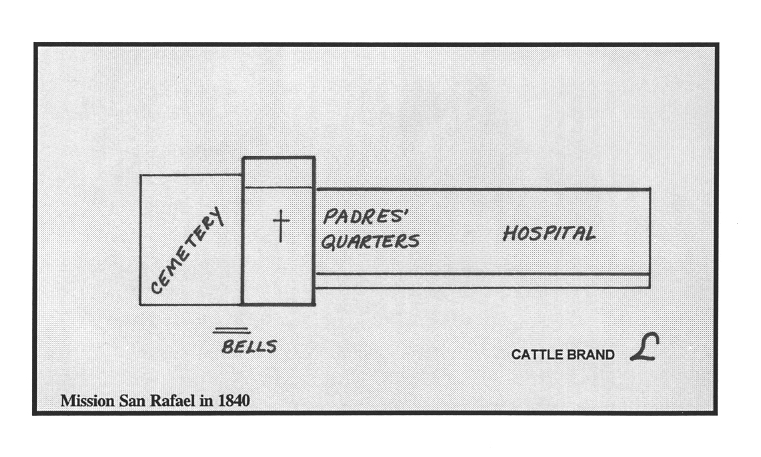| ||||
|
| ||||
|
MISSION
SAN RAFAEL ARCANGEL
1102 Fifth Avenue
San
Rafael, CA
94901
Established: December 14, 1817
By: Father Vicente de Sarría, President of the missions at that time.
Order: 20th of the 21 missions.
Location: 15 miles north of San Francisco, between Mt. Tamalpais and San Francisco Bay, on the north side of the Golden Gate.
Named: For the Archangel Raphael, patron of good health, considered the messenger "who announces the healing of God." One of three missions named for angels.
California Historical Landmark No. 220
DESIGN OF THE MISSION
Mission House: Unlike other missions, a church was not the first building at San Rafael, which was established as a branch of Mission Dolores (in San Francisco) to serve as a sanitarium or hospital for ailing mission workers. Mission House was 87 feet long, 42 feet wide, with storerooms, kitchen, and living quarters sharing the building with hospital facilities. Made of adobe. The church was built a year later at one end of the Mission House.
Style: Mission House was plain, bordered on one side by a long porch held up by square wooden posts, with a thatched roof. Church was connected to the Mission House, set at a right angle to it. Church also was plain with a square door and small square window above it. Made of adobe. The baptistry was a small lean-to at one side of the building.
Bells: There was no bell tower or bell wall. Four small bells hung on a simple wooden frame just outside the entrance to the church.
Mission Grounds: The traditional quadrangle of mission buildings was never developed at San Rafael. Nevertheless, many Costanoan and Coast Miwok Indians became a part of San Rafael Mission, and a colony of native huts surrounded the Mission House. At first, the main business of the mission was healing. The damp, foggy weather at Mission Dolores added to the slow recovery of the victims of the new diseases brought by settlers and soldiers. Mission San Rafael, on the other hand, was in a sunny, sheltered spot, which helped people get well. The hospital was first supported by supplies from Mission Dolores. Soon, however, the San Rafael workers were raising a small herd of cattle and harvesting crops, even more than they needed to feed themselves. There were skilled workers in other trades as well, including boat building. This was one of the few missions where boats were built.

EARLY HISTORY
1817 Mission founded as a hospital branch for Mission Dolores, and also to protect the Spanish interests against the Russians, who had established Fort Ross on the coast to the north. Father Luis Gil y Taboada (from La Purísima Mission) placed in charge because he had medical knowledge. Hospital building erected.
1818 Church added to one end of the original building.
1822 Full mission status was given, under the leadership of Father Juan Amorós.
1828 It is recorded that more than 1,000 people were living at Mission San Rafael.
1834 Mission secularized; taken from the Catholic Church and put under the control of Governor Mariano Vallejo (commandant of the San Francisco Presidio). Vallejo took much of the livestock, equipment and supplies, and even the fruit trees, to his ranchos in nearby Sonoma.
1842 Mission abandoned; lands sold.
1846 Captain Frémont and his men found the buildings deserted and used them as shelter.
1855 6½ acres of land returned to the Catholic Church, but the building was in ruins.
1861 Sold to a carpenter, who soon demolished the church.
1869 Gothic-style church built on the site.
MISSION SAN RAFAEL TODAY
Nothing remains of the original Mission San Rafael buildings, and no actual plans exist to show how they were laid out. In 1949, with funding from the Hearst Foundation, a new Mission San Rafael church was constructed. This building is near the original site, though oriented in the opposite direction. It faces the mountains, while the old mission church faced the bay. It is crowded onto the property of St. Raphael’s Church, a larger church on the site that serves as the parish church.
The new Mission San Rafael is made of concrete plastered to look like adobe bricks. The design of the building relied on artists’ drawings and remembrances of people who had seen the old mission. One artist, drawing pictures of the missions for a series of postcards in the early 1900’s, added a star-shaped window above the door. This is similar to the star window at Carmel Mission. The postcard artist may have wanted to make the little mission church look fancier. When the reconstruction was done in 1949, the postcard picture was thought to be accurate. It is now considered most unlikely that Mission San Rafael had such a window.
The bells at Mission San Rafael hang from a simple wooden frame in the front yard. The interior of the new mission church is modern in design with only a few mission-style features, such as an arched sanctuary and deep-set windows.
A small museum in a wing attached to the church exhibits some paintings of the original mission and the few existing statues and art objects from the mission, plus some objects from other California missions.
